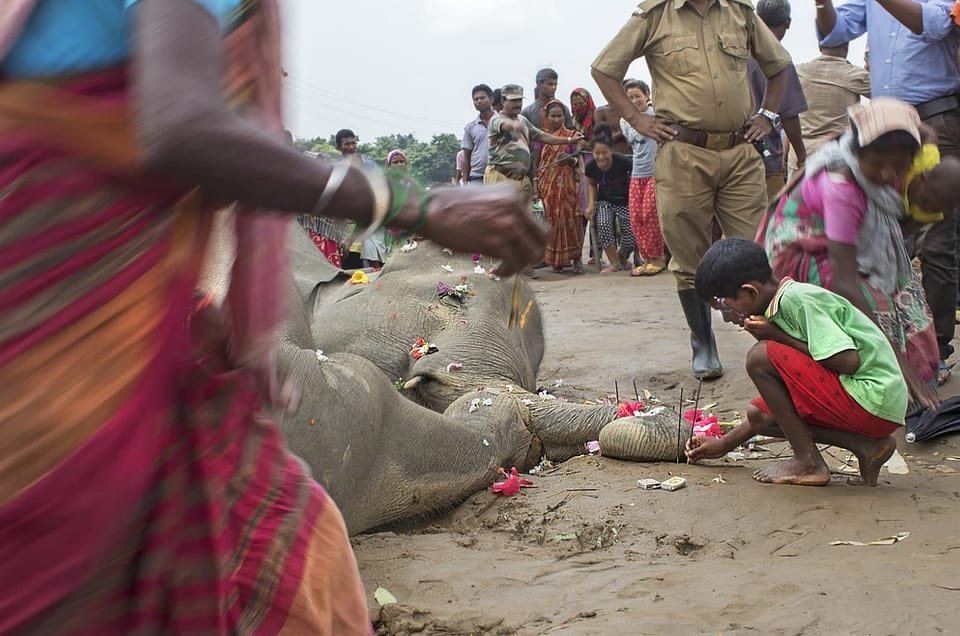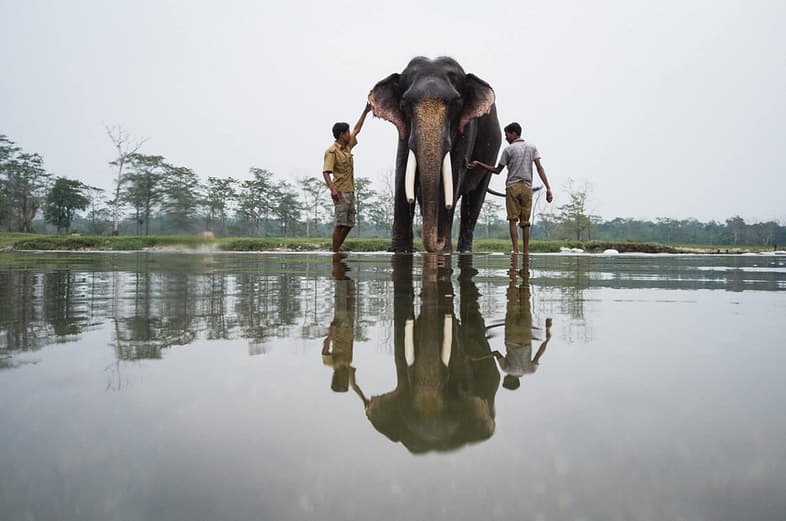
https://maptia.com/jodymacdonald/stories/keepers-of-ganesh-the-vanishing-art-of-mahout
Most mornings, they meet in the forest as the night sounds wane and crows of roosters mark daybreak. The black sky becomes a tinted blue, the white sharp shapes of the distant Himalaya poke out from the river mist that rises into the cool air and spills out over the nearby meadow. Suriya, a massive Asian elephant tusker, can hear Faridul, his lanky, soft spoken mahout of over 14 years, long before he enters the single trail that winds into the protected forest at this national park in North Bengal, India. They greet one another with a quiet knowing, stroke of hand, wag of tail. Suriya sets down his trunk to the ground and pushes his massive ears forward for Faridul to grip like handles and nimbly climb up, settling on his broad back. The sun breaks through the clouds and the two wind their way, meeting up with the other elephants and men returning from night patrol.
A slim winding path through dense vegetation, the continuous tree canopy shelters from a sudden soft rain. Rain drops on fat leaves, branches cracking underfoot, periodic soft calls of the mahouts: Meil, Meil, to move them along. Rustling overhead as elephant trunks rise to pluck leaves and sticks along the way. Plodding feet, slow and deliberate.
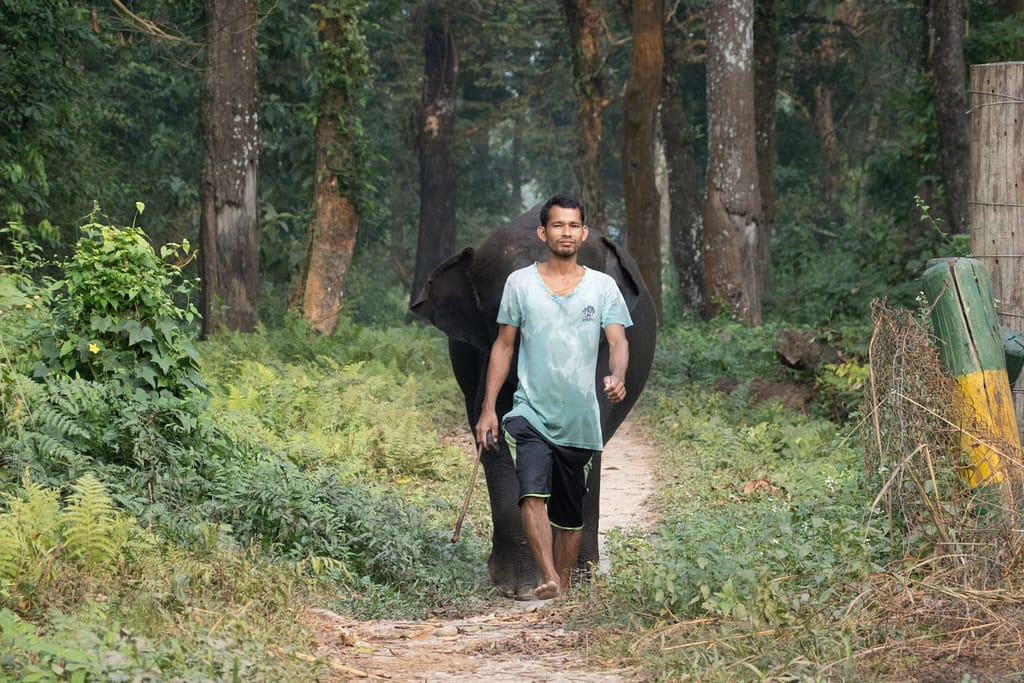
They make their way toward the Pilkana (elephant shelter/stable), which is steps way from a stilted wooden structure that serves as a preparation center for journeys and patrols through the park. The building is built on pilings with roof overhangs to protect against the heavy rains and flooding during monsoon season. It contains all the mahout/elephant tools, equipment, feed and medical supplies. Several single room homes form a semi-circle, opening out into a grassy courtyard within a stone’s throw from both the staging and equipment building and the Pilkana. Senior mahouts, patrol officers, and their families live here. Surrounded by forest on three sides and a short walk to the Murti river, this is the home base for the six elephants and twelve mahouts that work as a team for the North Bengal Forest Department.
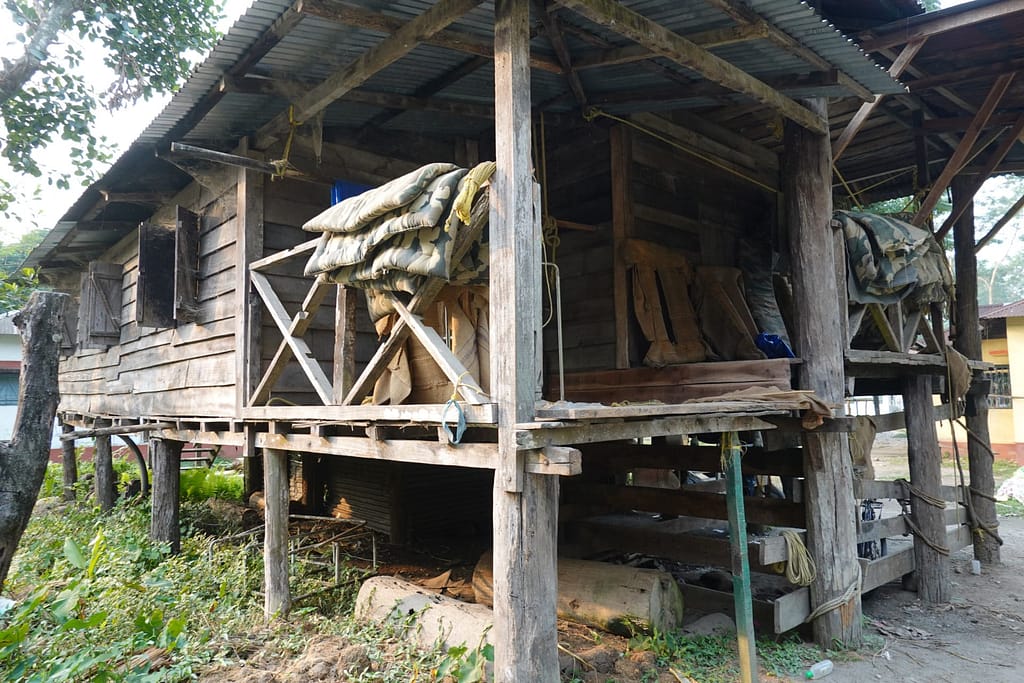
Elephants, horses, camels, elephants, oxen, dogs, mules… From the dawn of time, humans and certain animals have developed a complex synergy, a reliance on one another that has, at its root, the meeting of both of our most basic needs: food and shelter. A delicate balance of co-existence—in many cases fraught with domination and cruelty, and in countless relationships an exchange of deep love and affection, often times both.
Human and animal partners have built empires together, travelled impassable terrain, staved off enemies, paired to make a living, and assist those that need mental, emotional or physical support. Just as wild horses are captured and then trained for equestrians as partners in sport and pageantry, and for cowboys to work on ranches and rangelands, wild Asian elephants in India have been captured and trained to worked alongside humans for millennia. Historically, as objects of worship and ceremony, weapons of war, and employees of the logging industry, contemporary captive elephants continue to transport humans through impassable landscapes and are valuable partners for wildlife conservation and forest protection.
For over a century Forest Departments in India have employed elephants and mahouts for use in conservation and as a strategy to help mitigate the human-elephant conflict. Each elephant requires two full-time caregiver/trainer/drivers, a mahout and his apprentice (called the Patawala) to meet their needs. The traditional wisdom of mahout, passed down, for generations within tight communities, involves deep and direct studying of elephant behavior, knowledge of forest grown medicines, meticulous attention to care and feeding, and a rich cannon of lullabies and soothing melodies. As economic opportunities for mahout-elephant work teams are no longer viable, families seek other work and they are no longer teaching the next generation of mahouts. Consequently, forest departments throughout India are finding themselves in a crisis. As the need for qualified mahouts increase, those who hold the indigenous wisdom are becoming few and far between.
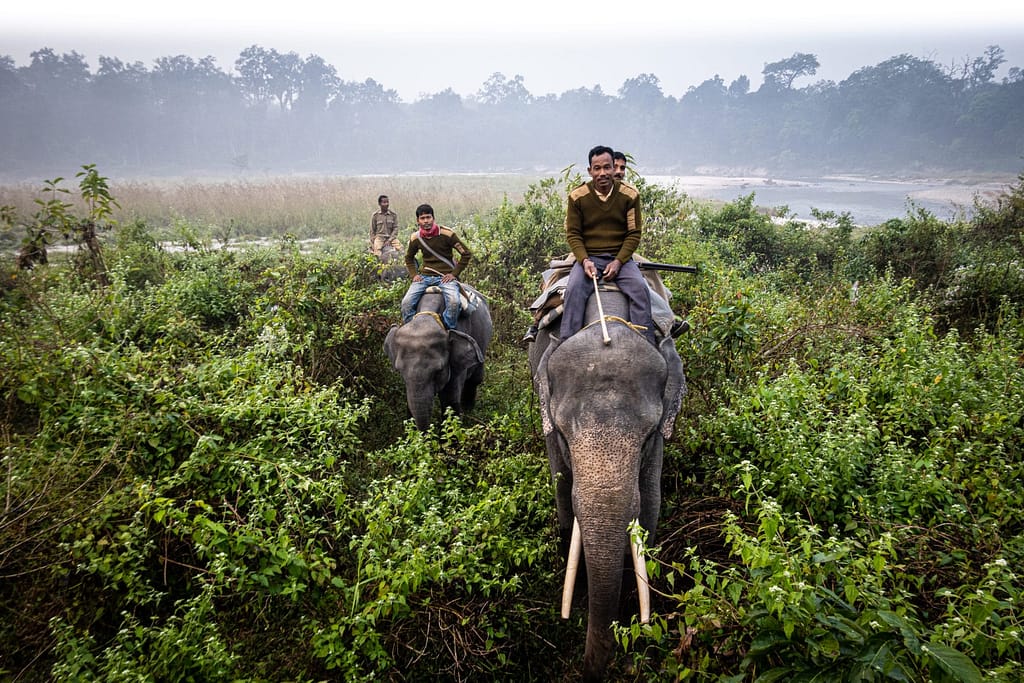
The pilkana at 5am is bustling with activity. The patawalas arrive on elephants carrying piles of grass stalks. Melodic short chants drift across the clean and well-raked protective space. The calls are instructions in a language the elephant and mahout have been using to communicate for centuries. In what looks like a choreographed dance, Suriya kneels on his back legs to allow grass bundles to slide effortlessly from his back, fanning out in exactly the right position at the front of his feeding station. Surya’s assistant mahout retrieves the tin buckets half-filled with a nutritional supplement of wild rice, rice syrup and other natural ingredients. While elephants in this Forest Department camp spend their much of their day and overnights grazing relatively freely in the surrounding forest, this supplemental nourishment is necessary. Gone are the vast swaths of rich forests abundant with the array of nutrition a herd of elephants optimally need.
Crouching next to the distinct piles of grass, bucket at his feet, the patawala takes handfuls of long grass, folds them in half, snaps each over the bucket edge, then pulls the conglomeration apart to make a rowboat shaped container with long reeds trailing behind it. With his hands, he scoops out a precise serving of rice mixture and wraps the remaining grass to create a lid. To secure the bundle, two long strands are woven around the pod in an intricate tie that appears to have at least four variations. Faridul, Surya’s lead mahout, comes over to help.

The bond between elephant and mahout is the most critical aspect for all their work together. If Faridul is only authoritative and the patawala the main source of all food, the delicate bond can become imbalanced. Besides, this tusker will consume about 20-30 pods twice a day. No sooner is one made as it has been popped into the elephant’s mouth, eating the works of art as if they are handfuls of nuts.
I am mesmerized at their deftness. Satish, a former construction worker and mahout to Saboney, one of the smallest elephants, calls me over to give it a try. I am eager to learn. Fold, bend. “No. no,” he smiles and shakes his head. “Show me again,” I say and gesture as I do not speak Bengali. The rice sticks to my hands as I try to pack it into the lopsided bowl I’ve managed to make. Now for the tie. It breaks, breaks again, and on the third try it comes undone. Satish laughs and still takes the time. The mahouts don’t seem to mind that their hard work disappears so quickly, this ritual is an important part of the care and feeding cycle between mahout and elephant, just one of the many highly specialized techniques that have historically has been passed down for generations within mahout families. Only after the elephants have eaten do the mahouts return to their families to eat their own breakfast before returning to the day’s work.
It is the end of August and the rains have been steady for days. Jody and I have been to this camp twice, once when the six tiny raised huts, with one double wood platform bed, held tourists. And now, three months later, during the monsoon season when the park is officially closed. Still, the elephant patrols and 24-hour care and feeding continue through the high waters and bouts of torrential rain. We have secured the necessary permissions to allow us to observe, document, and interview and are grateful to be here. We quickly unpack and gather our things to head to the river so can we document and observe the daily bathing rituals. Life at this particular elephant camp has a routine cadence and a rotating schedule designed to protect the elephants with bouts of rest and limited hours of patrol.
Confident that we know the way, we start down the path.The trail is a bit washed out and muddy. My flip flops kick mud behind me and suck into the ground. Ahead of us is the watch tower, a high sheltered wooden square that appears wildly unstable but we are assured it is solid (it has since been swept away). The tower is perched on the banks of the Murti river. Once placid and peaceful, it is now raging with only small pockets of safe eddies for the mahouts to bathe their elephants. We make our way, but what was once a rock skipping stream crossing is now knee deep with small rapids. My choice of skirt is unfortunate, and it drags in the water despite my efforts to raise it without dropping my stuff. I haul my sopping wet self-up two steep ladders to the shelter where five mahouts are playing a raucous game of cards while they wait for the patawalas to bring the elephants in from the forest where they have been spending the much of the day eating and socializing with one another. The rain is making the river tumultuous and at the first sight of the elephants, the mahouts stand and begin to pack up. Kurki knives hang from cords tied around their waists, tucked into hand carved sheaths their long curved blades good for everything from for cutting grasses and stalks to filing tusks and nails. In each of their hands, a natural pumice stone to scrub and clean their elephants.
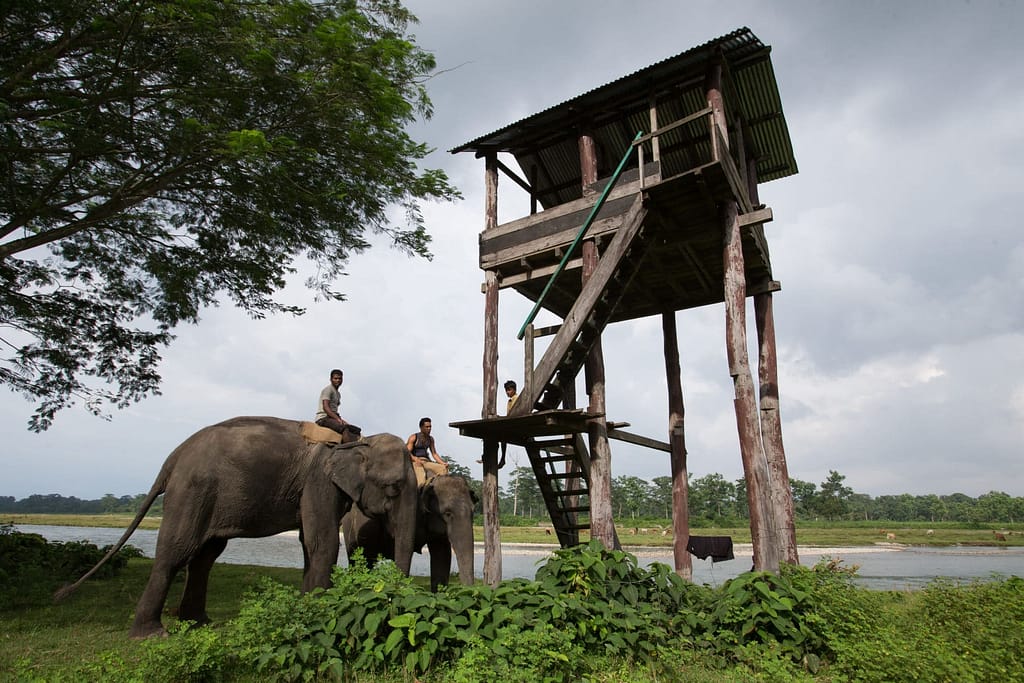
The patawalas and elephants filter in a little at a time from different directions. Up the riverbank and out through the forest come Hilary and Daina. The mahouts explain that these females are best friends and often spend their free time chatting and snacking in close proximity.
There is a farmer stranded across the river on the shore. He has a backpack and seems to have timed his appearance in the hope of catching a ride back across on elephant back. The river is far too treacherous for a human to attempt a swim. He is in luck, Suriya is approaching through the grasslands. The Patawala and Suriya help the farmer climb on. At the deepest point, the water covers the men’s feet, Suriya moves with grace, agility, and strength, a strong wake of waves flanks his sides as he makes his way to shore.
Bath time is a highlight of the day for both elephants and their mahouts. A time for games and socialization, the elephants soak and spray themselves in the river while the mahouts play cards on the bank, with eyes seemingly behind their heads as they periodically call out commands. With no tourists for weeks, the mahouts seem less inhibited, yet the high water is cause for caution. The space available for the elephants to float and relax is limited to a relatively small eddy. I am relieved to see that Raja, one of the smallest of the group, a young male with tiny nubs for tusks, is finally joining the others. Last time he was not permitted this social hour and was tied to a nearby tree, only bathed after the others had left. He is acting like a bully, the others had explained, disturbing the other elephants by poking at them and trying to pick fights. He must be separated so they do not suffer from his unsocial behavior.
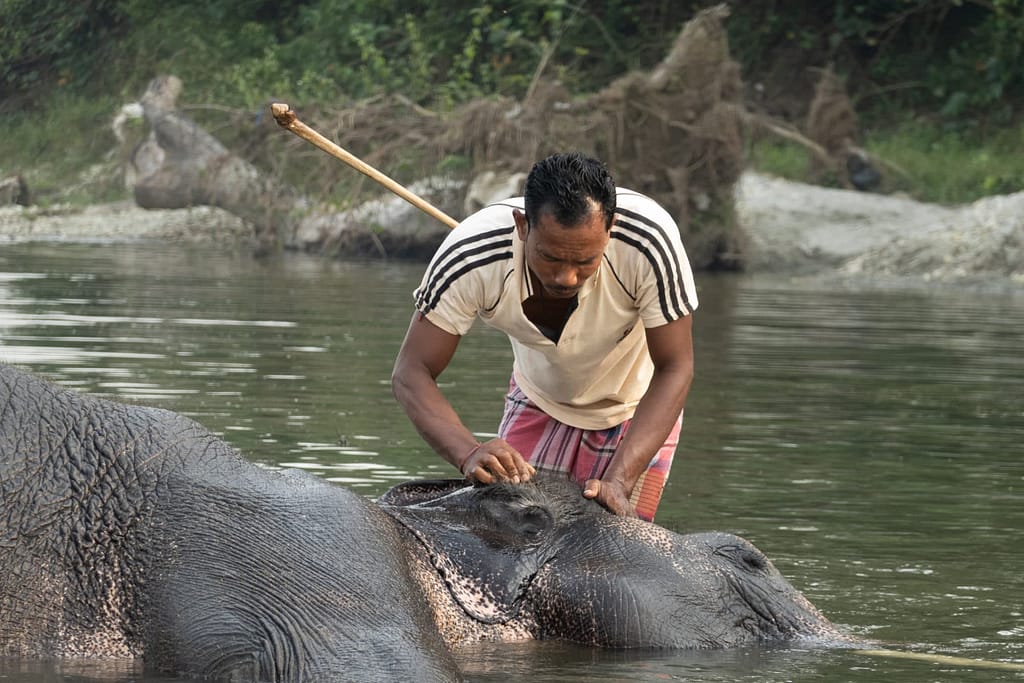
In the wild, herds are matriarchal, and primarily made up of females entirely- only one male has a guaranteed role in the herd as a protector for the others. The female is the leader. Young bull elephants leave the herd once they reach their teen years. Sometimes they gather into a group with other males, but often they hang alone. In the absence of reliable food and forest landscape to fulfill their needs, many solitary bulls attach themselves to villages throughout the traditional migratory area, learning the comings and goings of each person who lives there and the timing of crop cultivation, to supplement his limited food source. At this camp, Suriya appears to be in the role of male protector for the four females. Raja has to re-adjust and apparently has succeeded as he is now in the water with the others. True he is poking Saboney with his trunk, trying to get her attention. But she just settles back under the water as if she’s fast asleep and can’t be bothered. He eventually gives up.
Without highly specialized mahouts who practice the finely tuned art of devotion to their elephant, the fragile bonds between them threaten to break down, putting both at risk. There is a rich cannon dictating care, guidance, and discipline that must be adhered to for health and safety of elephant and mahout.
In the absence of indigenous wisdom being taught in real time, specific guidebooks have been written illustrating in great detail best practices in the entire gamut of captive elephant care and management. Men hired to be mahouts who have not had the experience of growing up with elephants, under direct training, over many years, run the risk of resorting to domination and violence to control their elephant. A mistake that can prove harmful to the animal, and ultimately deadly for the mahout. For example, during one of my river observations, an instance when the camp’s head mahout and his elephant were on brief leave, a young brash mahout who always seemed to exude malevolence, struck his elephant in a way that appeared to be unnecessarily cruel. I could not watch the behavior of this mahout without coming away with the strong opinion that this mahout will eventually become a statistic with the elephant on the winning side. This thought is doubly sad because you can imagine that the elephant will be blamed, when in fact the human is wholly responsible. His elephant, indeed, all of them, have the capacity in an instant to use their trunks to pluck and fling to his death any human within reach. And while they may have a foot tethered in the Pilkana, their trunks are always free.
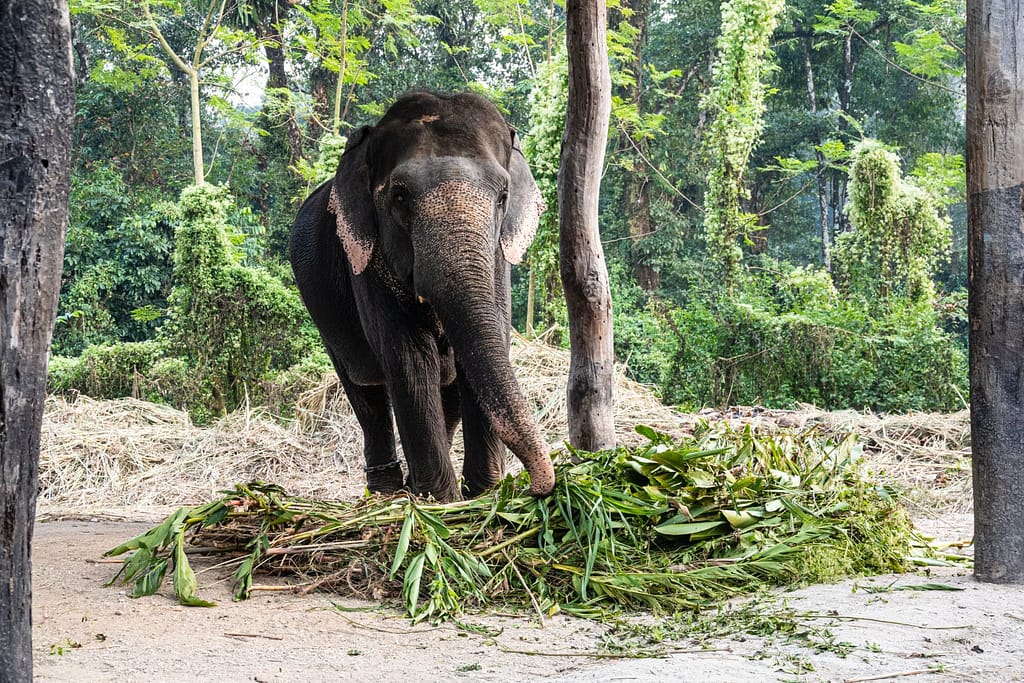
In stark contrast, Faridul, who trained as the patawala to Dinobunde before becoming full mahout to Suriya, exhibits a calm, steady manner at all times. Once, Suriya with Faridul at the helm and the Department’s beat officer behind him, clinging for dear life, safely drove off a herd of 100 elephants that had come to consume a nearby village’s crop fields. This is a common occurrence during maize cultivation season and, if not managed carefully, results in the injury or death of human and elephants.
“I was not afraid,” says Faridul, his tall thin frame seemingly made only of bird bones. “I trust Surya completely.” He is tending to large boil on Suriya’s rear leg. Crouched alongside a a massive pot of water with healing herbs and medicine boiled over an open fire, Faridul soaks a compress. Wise mahouts would follow their sick or injured elephants into the jungle because they understand that the elephant will seek out the medicine they need within their habitat to heal what ails them. The mahout will then observe the natural healing and document the medicinal source, contributing to indeginous knowledge of medicine that is still used today. Faridul is 32 years old. He has a wife, a daughter, and infant son. He has been with Suryia first as his patawalla and then mahout for 14 years. Mahout wisdom proports that an elephant picks up the temperament of his mahout, and vice versa. That, over time, the two mirror one another. Faridul and Suriya are living examples of this ancient adage.
“When Suriya is happy, I am happy. When he is angry, I feel that way too. If he is unwell, it makes me the same,” Faridul says as he presses a hand to Surya’s girth. The conversation is clearly over as he bends to one knee beneath his elephant and with the concentration of a tightrope walker applies the compresses to Surya’s leg. In turn, the elephant is patient, even kneeling on command, allowing Faridul to get deeper into the wound.

The elephants here were originally found orphaned, without their herd, starving and displaced. And while that helps explain why they are here, it does not make the fact that the training can be cruel and their lives are not free any easier to digest. Similarly, it is just as difficult to see the mahouts working around the clock for scant pay and lost social status, struggling to find time for their families. They both seem like outcasts, existing together on the margins of the modern era. There are no easy solutions or answers. Captive elephants are relied on by the Forest Department as valuable members of anti-poaching and patrol teams. For now, they remain a critical piece of an overall set of long and short-term strategies to save the Asian elephant from extinction, in a part of the world where habitat loss is so rampant that elephants are being squeezed out of their once verdant space. The elephants are able to silently move through thick vegetation with mahout handler and Forest Department patrol safely lifted off the jungle floor. They can travel deep into the forest where no vehicle can enter. Here, the patrol team assesses the health of the one-horned rhinoceros, for which this land is historically a breeding ground, thwarting poachers, and in some cases the teams are employed to expertly help drive out wild elephants herds from marauding, destroying crops, damaging homes, and killing people during cultivation season. For the six elephants and twelve mahouts of this north Bengal elephant camp, the traditions are palpable, and health and safety guidelines govern.
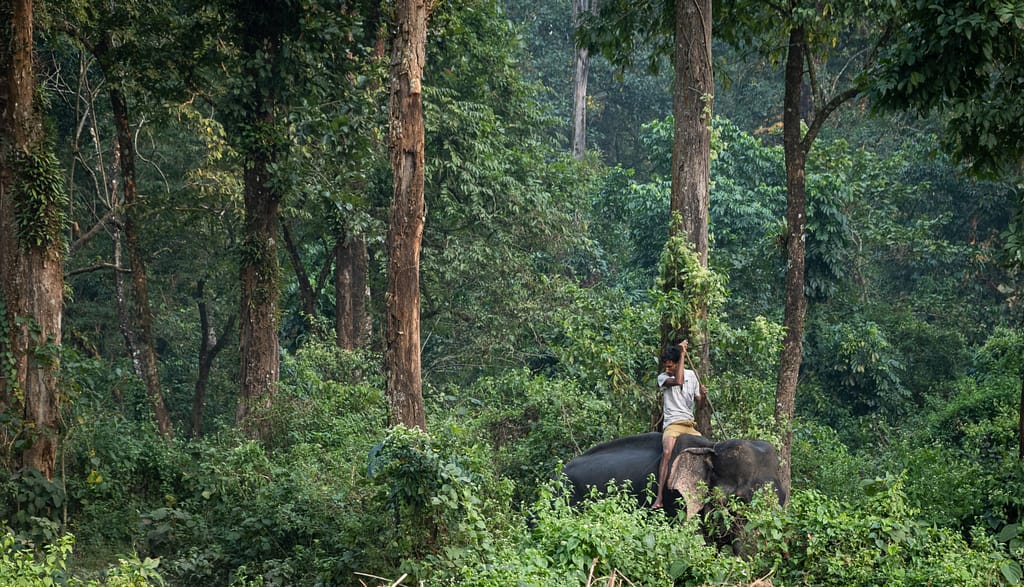
With the human-elephant conflict in northern India at a fever pitch, desperate measures are being taken to protect both elephants and people using the least harmful means possible. While most will agree that, ideally, elephants should remain wild in jungles and forests across Asia and humans should stay out of their way, that reality has long since passed. There are virtually no more uninterrupted swaths of abundant forests for the elephants to inhabit unmolested.
While many square kilometers of natural forest have been protected in the form of national parks, offering a lush and protected oasis, they exist as reminders to what has been lost. Elephants are migratory animals and their needs are super-sized. An optimal home range for earth’s last giants should be between 650 and 200 square kilometers. To shed insight on the dietary needs that these habits must fulfil, elephants eat approximately 10-15% of their body weight every day. This translates to upwards of 200 kilograms of vegetation and about 200 liters of water per day. Human encroachment has shrunk the existing range size to less than 150 square kilometers, forcing elephants to be squeezed along the ancient migratory routes. Now, there are only pockets of natural jungle interspersed among a variety of human created blockages: tea gardens, villages, highways, trains, electric fencing, industrial buildings, army barracks.
Where once 300,000 Asian elephants roamed throughout uninterrupted landscape, now only 30,000 remain, forced to share depleted resources with other squeezed out wildlife and a still-growing mass of humanity.
Add the effects of climate change, with widespread drying up of traditional watering holes and streams, the situation seems hopeless. One beacon of hope in the face of this dire situation is the restoration of vital corridors to link swaths of habitat toward the vision of creating a safe passage for elephants to migrate. A cooperative effort spanning the country, Wildlife Trust of India, in partnership with Elephant Family, has identified 101 corridors and they are building partnerships with strong results that include elephant friendly tea gardens, relocation of villages, lobbying to block development and model green over and under passes for avoiding highways and rail lines. Solutions like these cannot wholly restore the magnitude of what has been lost but can, and do, save human and elephant lives.
Saving the endangered Asian elephant requires culturally appropriate, realistic and ever evolving solutions. In India, there are thousands of working elephants still in captivity. Mahouts with specialized training, who are devoted to their elephants and supported with the economic and social status they deserve, offer a strong chance for captive elephants to thrive.
For the elephants and mahouts at this Forest Department camp, life follows a cadence, both daily and seasonally, with close to ideal environmental conditions: lush forest, a significant year-round water source, and a tight-knit community within a village that is not overcrowded. In the evenings, as the sun sets, the women come out into the courtyard to socialize while their children spin and chase one another around the grounds. The elephants rest and eat before night patrol, the mahouts have a quick break themselves. Faridul gives up his precious free time to talk with me. I ask, if he had so much money that he would never have to work another day in his life, would he still be a mahout? He looks down and softly shakes his head with a shy smile.
“Yes, of course,” he says, “I will be with Suriya for my entire life.”
Yet, when I ask if he plans to teach his son the art of mahout, his face clouds over and he looks out over the forest and pilkana, then back at me.
“No,” he says. “It is too difficult a life. I do not wish that for my children.”
Their story represents just a small, but mighty, component to the variety of conflict solutions being employed by NGO’s, private sector, individuals, and government across India. However, these particular elephants and their dedicated mahouts are partners on the front lines of the wildlife conflict. One cannot help but feel that they are, perhaps, sacrificing their individual freedom for the rest of their lives to guarantee the increased possibility of survival of both their species. Let’s hope their sacrifice will not be made in vain.


